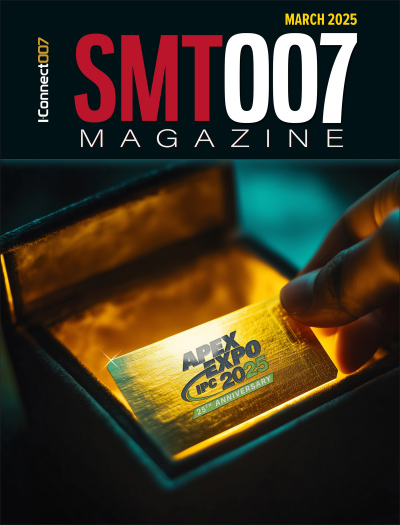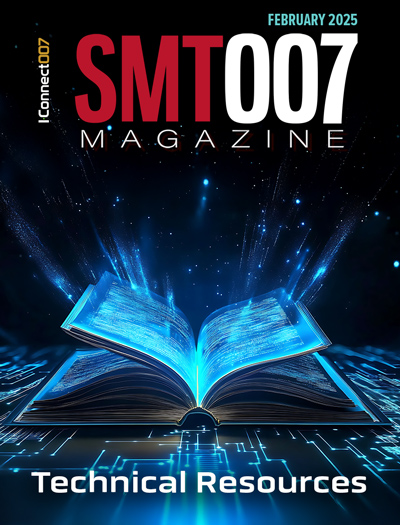-

- News
- Books
Featured Books
- smt007 Magazine
Latest Issues
Current Issue
Do You Have X-ray Vision?
Has X-ray’s time finally come in electronics manufacturing? Join us in this issue of SMT007 Magazine, where we answer this question and others to bring more efficiency to your bottom line.

IPC APEX EXPO 2025: A Preview
It’s that time again. If you’re going to Anaheim for IPC APEX EXPO 2025, we’ll see you there. In the meantime, consider this issue of SMT007 Magazine to be your golden ticket to planning the show.

Technical Resources
Key industry organizations–all with knowledge sharing as a part of their mission–share their technical repositories in this issue of SMT007 Magazine. Where can you find information critical to your work? Odds are, right here.
- Articles
- Columns
Search Console
- Links
- Media kit
||| MENU - smt007 Magazine
Microscopy Advance Reveals Unexpected Role for Water in Energy Storage Material
May 29, 2018 | NC State UniversityEstimated reading time: 1 minute
A material with atomically thin layers of water holds promise for energy storage technologies, and researchers have now discovered that the water is performing a different role than anyone anticipated. The finding was possible due to a new atomic force microscopy (AFM) method that measures the sub-nanoscale deformation rate in the material in response to changes in the material caused by energy storage.
AFM reveals that structural water in tungsten oxide results in smaller deformation rates from ion intercalation, an unexpected finding on the role of structural water that can enable materials with higher power and efficiency energy storage devices.
The researchers studied crystalline tungsten oxide dihydrate, which consists of crystalline tungsten oxide layers separated by atomically thin layers of water. The material is of interest because it holds promise for helping to store and release energy quickly and efficiently. However, it has not been clear what role the water plays in this process.
To address this question, researchers from North Carolina State University, the Oak Ridge National Laboratory (ORNL) and Texas A&M University used a new methodology. The new technique relies on AFM to track the expansion and contraction of the material at the atomic scale and in real time as an electronic instrument called a potentiostat moves charge in and out of the material. This technique allowed the team to detect even minor deformations in the material as charge moved through it.
“We tested both crystalline tungsten oxide dihydrate and crystalline tungsten oxide – which lacks the water layers,” says Veronica Augustyn, an assistant professor of materials science and engineering at NC State and corresponding author of a paper on the work. “And we found that the water layers appear to play a significant role in how the material responds mechanically to energy storage.”
“Specifically, we found that the water layers do two things,” says Ruocun “John” Wang, a Ph.D. student in Augustyn’s lab and lead author of the paper. “One, the water layers minimize deformation, meaning that the material expands and contracts less as ions move in and out of the material when there are water layers. Two, the water layers make the deformation more reversible, meaning that the material returns to its original dimensions more easily.”
“In practical terms, this means that the material with water layers is more efficient at storing charge, losing less energy,” Augustyn says.
Suggested Items
IEEE Study Leverages Silicon Photonics for Scalable and Sustainable AI Hardware
04/14/2025 | PRNewswireThe emergence of AI has profoundly transformed numerous industries. Driven by deep learning technology and Big Data, AI requires significant processing power for training its models. While the existing AI infrastructure relies on graphical processing units (GPUs), the substantial processing demands and energy expenses associated with its operation remain key challenges.
Dongguk University Researchers Advance Lithium-Ion Battery Technology with Hybrid Anode Material
04/14/2025 | PRNewswireResearchers from Dongguk University have achieved a significant breakthrough in lithium-ion battery technology by developing a novel hybrid anode material.
Foxconn Joins Hands with 30 Suppliers to Reduce Carbon Emissions by 15,000 Tons in Two Years
04/09/2025 | FoxconnHon Hai Technology Group, the world’s largest technology manufacturer and service provider, has participated in climate actions such as CA100+ and RE100 in recent years and pledged to achieve net zero emissions by 2050.
LiU and Siemens Energy Enter Into Strategic Partnership
04/01/2025 | Linköping UniversityIn order to find long-term solutions to future challenges in the energy field, Linköping University and Siemens Energy AB sign a strategic partnership agreement.
Meyer Burger, Memodo Sign Supply Agreement for Italy
03/28/2025 | Meyer BurgerMeyer Burger Technology AG and photovoltaic distributor Memodo have signed a supply agreement. The high-performance modules “Made in Germany” were manufactured at the Freiberg plant in Germany and are intended for the Italian market.


